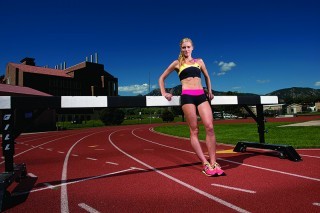Making the Leap with Star Steeplechaser Emma Coburn

Coburn has won four U.S. titles in the steeplechase since 2011 and owns the fastest time ever run by an American woman in the event. Photo: David Clifford
Emma Coburn is one of America’s best chances for a distance-running medal heading into this month’s IAAF World Championships in China. The front-running Coloradan takes us inside the steeplechase—the original obstacle course race—to see what makes it so difficult, dangerous and fascinating.
Let’s get this straight from the start: The 3,000-meter steeplechase is by far the most peculiar—if not the most difficult—distance running races out there.
The “steeple” is a savage compromise of strength, speed and endurance, and it entails running nearly 2 miles at a crazy-fast pace (about 4:50-mile pace for women, 4:20 for men) while negotiating 35 barriers—seven of them in front of a daunting water pit—in what might best resemble a sadistic equestrian event.
The steeplechase barriers are not the lightweight aluminum hurdles set up by school kid volunteers that tip over when you brush your knee against them. A 30-inch high, black-and-white-striped steeplechase barrier is an unmoving, 13-foot-wide, 220-pound mammoth of an obstacle. Clip a toe and you kiss the track. Hit your shin and you’re scarred for life. Or you end up submerged in the water pit to the cheers of bloodthirsty fans who crowd at the edge of the pit, smartphones poised, praying for YouTube-worthy carnage. Competitors have scars on their inner thighs from where the underside of a track spike sunk into their flesh during a group hurdle.
There’s a unique pain in watching an amateur steepler drag herself through the course, looking more ragged with each lap and more afraid as she steps on the water jump barrier. The pros aren’t exempt, either. At the 2012 London Olympics, Birhan Getahun of Ethiopia slammed into the final hurdle and exited the track in a wheelchair. A wrong step has sent thousands of athletes head first into water pits, most recently in the prelims of the 2015 U.S. track championships in Eugene, Ore., in June.
The 3,000-meter steeplechase is the track and field equivalent of a Benny Hill chase scene.
Why would anyone want to run the steeplechase? A runner would have to be crazy, masochistic or just a genuine badass to willingly submit to that event. Emma Coburn, who became the fastest American steeplechaser in history last summer, one of the U.S.’s great hopes for Olympic glory and the woman who will push the boundaries of what’s possible, is definitely the latter. And it just so happens that Coburn, 24, thinks obstacles are fun, too.
While men have been competing in the event since 1896, the steeplechase didn’t debut in the women’s NCAA national championship until 2001 and the Olympics until 2008. At first, college coaches weren’t willing to sacrifice their fastest runners to the obstacle course, and it became a dumping ground for athletes who couldn’t keep up in the ultra-competitive 1,500 meters or handle the sustained grind of the 5,000. The rationale was, maybe these athletes will be more competitive if we make them jump over stuff, too.
Then women hit their stride and the steeplechase became competitive. Seven years ago, Jenny Simpson (née Barringer) blazed a new American record in 9:22.73 as a junior at the University of Colorado, breaking it the next year with a 9:12.50 in Berlin.Coburn, then an 18-year-old sophomore and fellow Buffalo, was paying attention.
The native Coloradan grew up in Crested Butte, a mountain town at the end of a highway where a four-season high school athlete (cross country, volleyball, ice hockey, track) complemented school sports with downhill skiing, kayaking, mountain biking and hiking in her downtime. Outmaneuvering people comes second nature to mountain kids, and Coburn’s role as outside hitter in volleyball and leaper-of-jump-balls in basketball meant the girl had ups.
In 2007, the high school junior stepped into her first 2,000m steeplechase in Albuquerque, N.M. Coburn and her family had driven five hours for her to run the 800 meters, and they figured she might as well do something on Day 2. Her race form may not have been pretty, but Coburn, born scrambling up mountainsides, gleefully tackled the hurdles and water jump.
“Every lap, I had something to look forward to,” says Coburn, sitting at Pekoe Sip House in Boulder, picking at a pastry as her 2-year-old rescue mutt, Arthur, looks upward from beneath the table. “It was a challenge that gave me something to focus on other than the misery of running lap after lap. I liked the adventure of it.”
She qualified for the national championships and soon after got a recruiting call from Heather Burroughs, assistant coach to CU head coach and Olympic coach Mark Wetmore.
“When I was in high school, I wasn’t looking at high school or college times, I didn’t care about the professionals or dream about the Olympics,” says Coburn, who now surrounds herself with Olympic training partners and distance running royalty Kara Goucher, Jenny Simpson and Shalaya Kipp. “When Heather made the recruiting call the summer after my junior year, I may have been a little too honest. I told her I wasn’t sure I wanted to run in college.”
Then Coburn stepped on the track at the 2008 Nike Outdoor Nationals and placed second. And for the first time, Coburn contemplated the possibilities of a future in running—and the mistake of telling the coach at her first-pick school that she wasn’t sure she wanted one.
RELATED: Video: Emma Coburn Talks Steeplechase
The post Making the Leap with Star Steeplechaser Emma Coburn appeared first on Competitor.com.
Ryan Hall's Blog
- Ryan Hall's profile
- 21 followers



